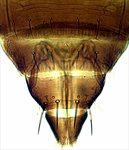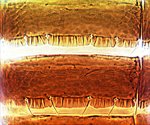Generic diagnosis
Female apterous. Head slightly prolonged anteriorly; maxillary palps 3-segmented; eyes with five weakly pigmented facets; ocelli absent; ocellar setae I present, II lateral to I. Antennae 8- or 9-segmented, segment VI with incomplete or complete transverse suture, I without paired dorso-apical setae, III and IV with sense-cones simple. Pronotum with no long setae, but one pair at posterior angles stouter but not conspicuous. Prosternal ferna undivided; basantra membranous without setae. Mesonotum without campaniform sensilla anteromedially. Metanotum without campaniform sensilla. Prosternal ferna not divided; basantra membranous. Mesosternum with sternopleural sutures reaching anterior margin. Meso and metasternal furca without spinula. Tarsi 2-segmented. Abdomen wider than thorax; tergites I–VIII with broad craspedum, median campaniform sensilla close to posterior margin, without ctenidia; VIII without posteromarginal comb; tergite IX usually with two pairs of campaniform sensilla, MD setae small; X with median split complete. Sternites with lobed posteromarginal craspeda, without discal setae, III–VII with three pairs of marginal setae, II with two pairs; VII with S1 setae in front of posterior margin, without craspeda between these setae.
Male similar to female; glandular opening between sternites II–III; tergite IX with two pairs of spine-like setae.
Biological data
Although usually associated with Poaceae, one of the two species in this genus, apteris, has been reported in California particularly from Erigeron glaucis [Asteraceae], and in parts of Australia and New Zealand from Medicago sativa [Fabaceae] (Mound & Marullo, 1996).
Distribution data
Of the two species, secticornis was probably Holarctic originally, whereas apteris was originally from the coastal region of southwestern USA. Both species have been recorded from China, Inner Mongolia (Hu & Feng, 2011).
Nomenclatural data
Apterothrips Bagnall, 1908: 185. Type species Apterothrips subreticulata Bagnall, 1908, synonym of Thrips secticornis Trybom, 1896, by monotypy.
This genus includes only two species (ThripsWiki, 2020), both of which are recorded from China:
apteris (Daniel, 1904: 295). (Sericothrips)
secticornis (Trybom, 1896: 620). (Thrips)
Relationship data
Thripidae sub-family Thripinae: this is a diverse group involving more than 230 genera. This genus is one of 40 in the Anaphothrips group of genera (Masumoto & Okajima, 2017). The two species in the genus were first distinguished by Nakahara (1988), and are interesting for the difference in the number of lobes of the sternal craspeda.
References
Hu QL & Feng JN (2011) Two newly recorded genera of the subfamily Thripidae Stephens,1829 from China with revision of genus Apterothrips Bagnall. Acta Zootaxonomica Sinica 36 (4): 865–870.
Mound LA & Marullo R (1996) The Thrips of Central and South America: An Introduction. Memoirs on Entomology, International 6: 1–488.
Nakahara S (1988) A new synonym and revised status in Apterothrips (Thysanoptera: Thripidae). Proceedings of the Entomological Society of Washington 90: 508-509.
ThripsWiki (2020) ThripsWiki - providing information on the World's thrips. <http://thrips.info/wiki/Main_Page>




